10 Hardest AP U.S. Government and Politics Questions
What’s Covered:
- How Will AP Scores Impact My College Chances?
- Overview of the AP U.S. Government and Politics Exam
- Preparing for the Exam
- 10 Hardest AP U.S. Government and Politics Questions
- Final Tips
This post will cover some of the harder AP U.S. Government and Politics questions. We will go through both the multiple choice and the free-response questions to give an overview of what to expect. We also offer a walkthrough of the exam: what kind of questions you’ll see on the test, what you’ll need to study, and which questions are trickiest for most students. Then, we’ll show you how you can ace your AP Government and Politics exam!
How Will AP Scores Impact My College Chances?
AP scores have little to no effect on the college admissions process. You aren’t required to report your AP scores on your application, and even if you self-report your scores they won’t really increase your chance of admissions.
With that said, colleges do care about course rigor. The AP classes you take and your grades in these classes are much more important to the admissions process than your AP exam scores. Earning good grades in several AP classes shows admissions officers that you challenged yourself and are prepared to take on rigorous college classes.
Want to see if your AP classes and course rigor will help you get into your dream school? Try our free chancing engine! This tool will allow you to see your chances of acceptance at over 500 colleges across the country. In addition to course rigor, our chancing engine also factors in your GPA, extracurriculars, demographics, and outside involvement, and will even provide tips for how to improve your profile!
Overview of the AP U.S. Government and Politics Exam
The AP U.S. Government and Politics Exam (a.k.a. AP Government Exam) is made up of two sections, each worth half the final score of the exam. Section I consists of 55 multiple choice questions with an allotted 80 minutes, and Section II consists of 4 free-response questions with an allotted 100 minutes. In total, the exam is three hours long. This may seem intimidating, but don’t worry, we here at CollegeVine have you covered!
The AP Government questions in Section I can be difficult, but are ultimately straightforward. These multiple choice questions are all about knowing your vocab! Section II can be especially confusing for some students, so check out the breakdown below to better understand what you’re in for.
Section II Breakdown:
- Question 1 is a concept application question. This section will require the student to apply political concepts to real-life and presupposed situations.
- Question 2 is a Quantitative Analysis question. A supplied graphic is the focal point of this question. It could be a line graph to read, a chart to interpret, or a table to explain.
- Question 3 is a Supreme Court Case Comparison Essay. This will have the test-taker apply Supreme Court decisions to real-life situations.
- Question 4 is an Argumentative Essay. You will use foundational documents to support an essay asserting your stance on a prompt.
Preparing for the Exam
The most important thing to do is study, but how do you know where to start? By the time you are preparing for your AP exam, you should know what your current grade is in AP Government. Start by studying the topics and areas where your scores dip down below your average grade.
Knowing your progress is paramount to doing well on the exam. If you can’t pinpoint which areas you struggle in, ask your teacher for advice and walk through your grades together. Once you know where to start, create a study plan for the areas you want to work on and decide which days you’ll study what content. It may be helpful to study with your classmates too! They’ll be able to offer advice on their test-taking strategies and you can all benefit from the shared knowledge.

10 Hardest AP U.S. Government and Politics Questions
The AP Government and Politics Exam Questions do not scaffold in difficulty. The most challenging questions may be placed right before the easiest one on the test. This can be tricky for students that are expecting the first few questions to be a breeze. It is important to treat each multiple choice question as its own separate challenge.
The following section is a preview of some of the more difficult AP Government and Politics questions, both multiple choice and free-response. Each answer will be provided along with an explanation. These questions were sourced directly from previous administrations of the exam.
The answers for the multiple choice section are indisputable, but there is much gray area for valid free-response answers. For this reason, the provided answer may not be exactly what you’re thinking, however your answer can still be correct.
Multiple Choice Questions
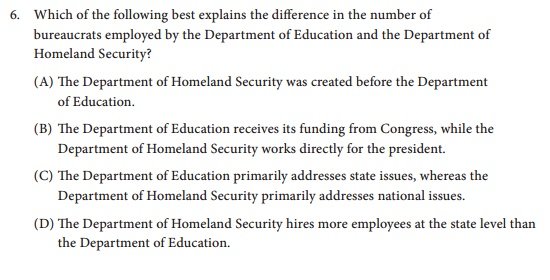
Correct Answer: C
The reason that there are fewer Department of Education bureaucrats employed by the federal government is because their issues are localized by state, whereas the Department of Homeland security primarily addresses national issues.
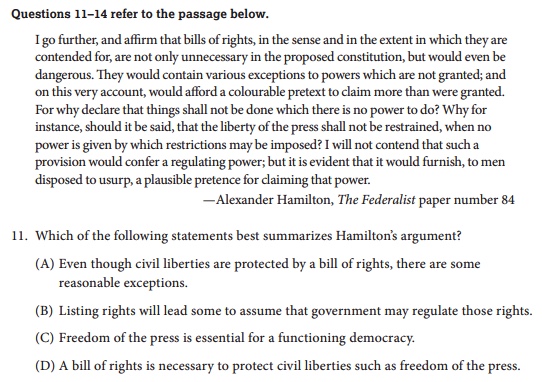
Correct Answer: B
The correct answer is B because Hamilton is wary of a government overstepping its boundaries. It is not C because there is ultimately little talk of the press in this passage. It is not D because Hamilton is against listing the Bill of Rights. Many students may think that the correct answer is A, but it is not because Hamilton does not find these exceptions reasonable.
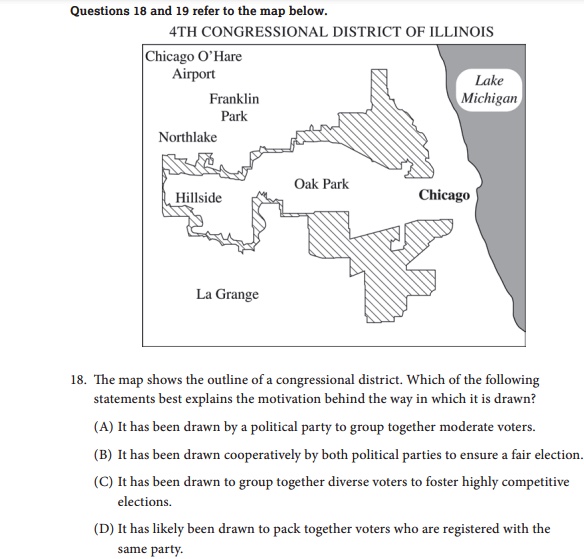
Correct Answer: D
The correct answer is D. This grouping together of similar voters is called Gerrymandering. Gerrymandering is when a congressional district is drawn to distort the real proportion of voters in an area. If there is a small majority of voters in one area, it can often be divided into smaller and oddly contorted districts that give the minority a slim but valid victory.
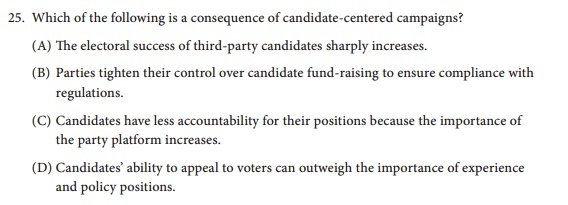
Correct Answer: D
This question can be tricky because it could be argued that A is a good answer since it could be true in some situations. Ultimately, however, D is the most correct answer. This answer has been proven repeatedly in American politics when popular candidates have won races because of their charisma rather than their policies.
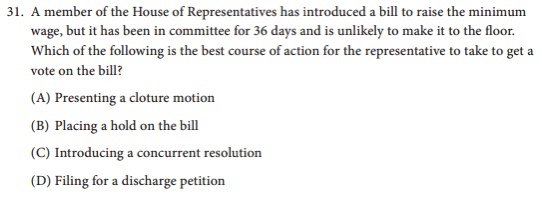
Correct Answer: D
Getting this question takes an in-depth understanding of bureaucratic procedures. You must know each piece of vocab used in this question to know which answers do not fit. For example, presenting a cloture doesn’t make sense in this situation because it is not the correct time for that procedure. Conversely, filing for a discharge petition is the correct answer because it makes sense in context.

Correct Answer: A
This question is purely a vocabulary-based question. If you know all of these models, you are good to go. An important tip to remember is that the trustee model is typically contrasted with the delegate model, so if you know one, you automatically know the other! This question can be difficult because the politico model is a combination of the trustee model and the delegate model.
Free-Response Questions
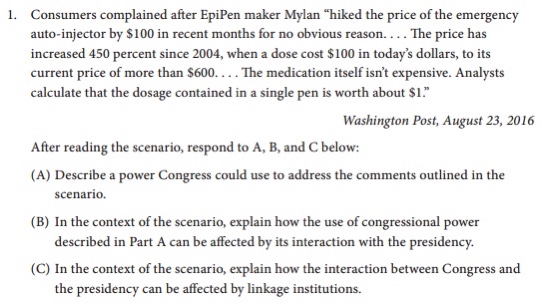
A student can score up to three points on this question by addressing each prompt correctly. For part A, the student should describe a political institution, behavior, or process connected with the scenario. For part B, they should explain how political processes, government entities, or citizens’ behavior can affect the policy mentioned in part A. The final part asks the student to use course content to relate the political institutions to the scenario.

There are four possible points to reap from this section. The first is from interpreting the graphic correctly, $8,000 to $9,999. The second part asks for any trend in the graphic. You could talk about how there is more spending in the north, or relatively less in the west, or another trend that you see. However, you must then support this assertion with evidence, which is worth two points. The final point is gained from a correct explanation of the principle of federalism as it relates to the graphic. For example, one could talk about the constitutional division of governmental powers and how it relates to public school funding.
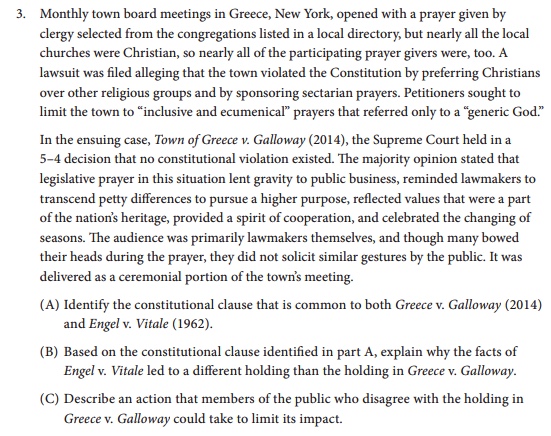
The third question in the free-response section, worth four points, is the Supreme Court Case question. The question above focuses on Town of Greece v. Galloway (2014). The first point is acquired by finding the similar constitutional clause between these two cases. The second and third points are earned by explaining the nuances of holding differences between the two cases. You must also explain why the information is relevant. The final point is obtained by describing the interaction between the holding in the non-required Supreme Court case and a relevant political institution, behavior, or process.

The final question is the argumentative essay. The prompt above allows for many different answers. A student could choose any of the three options and, if presented well enough, earn all six available points. In order to get a perfect score, you must: present a thesis statement, support your claim with at least two relevant pieces of information (one of the two coming from foundational documents), use reasoning to explain why your evidence supports your claim, and respond to possible refutations.
Final Tips
Know what to expect
After reading this article, you’ll be much more prepared for what you’ll see on the test. First, you’ll answer multiple choice questions based on charts, graphs and vocab. After that, you’ll write about Supreme Court Cases, do some data analysis, and create an argument based on a given prompt. That doesn’t sound too bad, huh! As always, consult your teacher if you have questions that were not answered in this article.
Study the vocabulary
Because the multiple choice section is so large, most of the questions can be done quickly, as long as you are able to quickly recall the vocab definitions. Make flashcards, highlight your textbook, and form study groups so that you know the difference between the Commerce clause and the Supremacy clause like the back of your hand.
You can’t start too early!
The earlier you start studying, the better you’ll feel. We’ve all had the experience of cramming for a test the night before – it’s not fun! For a test as big as the AP Government and Politics Exam, it’s best to start as early as you can so the night before you can relax and get a good night’s sleep. A rested brain is a test-ready brain!
Check out these CollegeVine resources for more help with your studying:
- Ultimate Guide to the AP U.S. Government and Politics Exam
- 2021 AP Exam Schedule + Study Tips
- How to Understand and Interpret Your AP Scores
- How Long Is Each AP Exam? A Complete List


